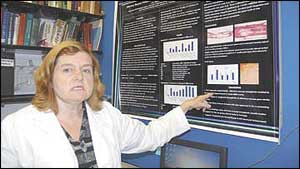
On September 16, 2010, the U.S. Senate Committee on Appropriations held another hearing on stem cells. The committee, chaired by Sen. Harkin, had asked to hear about the science of stem cells, but what they got was mostly politics. The witnesses praising embryonic stem cells had few facts or results, relying on hype and empty promises.
Only a single lone witness was invited to testify on the promise of adult stem cells, but Dr. Jean Peduzzi Nelson's testimony discussed real science and real results for patients. She showed five pictures of patients who had been treated successfully with adult stem cells, discussing their cases and the peer-reviewed scientific publications documenting the success of adult stem cells in each example. As she noted in her testimony:
"The progress of adult stem cells has gone so far beyond these particular patients to long term follow-up results of numerous patients in peer-reviewed published clinical trials."
The first example Dr. Peduzzi Nelson gave was that of Silvio, who was quadriplegic after a spinal cord injury at the base of his neck, "AIS Grade A". Grade A is considered the worst, indicating a "complete" spinal cord injury where no motor or sensory function is preserved in the lower body. Silvio was left with no movement of his legs and minimal movement of his fingers. At 2 years after injury, and after intensive rehabilitation failed to lead to an improvement,.he received his own nasal adult stem cells and partial scar removal.
Today Silvio can maintain a standing position and wave without help. With a walker and short braces, he can walk over 30 feet without anyone helping him. He can now move his fingers, which he could not do before.
Silvio's improvement is astounding. Usually only 5% of AIS Grade A patients improve in grade if a treatment is given at 1 year or greater after spinal cord injury. But using adult stem cells for treatment, Silvio is not an isolated case. Dr. Peduzzi Nelson has worked with Dr. Carlos Lima of Portugal on these adult stem cell treatments, publishing the results. In theirmost recent published study, more than half of the AIS Grade A patients improved at least one grade after adult stem cell treatment. When the adult stem cells are combined with an effective rehab program, 12/13 AIS A patients improved in AIS grade and all of the patients regained some muscle movement in their legs.
The results with patients have been published in the journal Neurorehabilitation and Neural Repair and in the Journal of Spinal Cord Medicine.
Contact: David Prentice
Date Published: September 26, 2010
